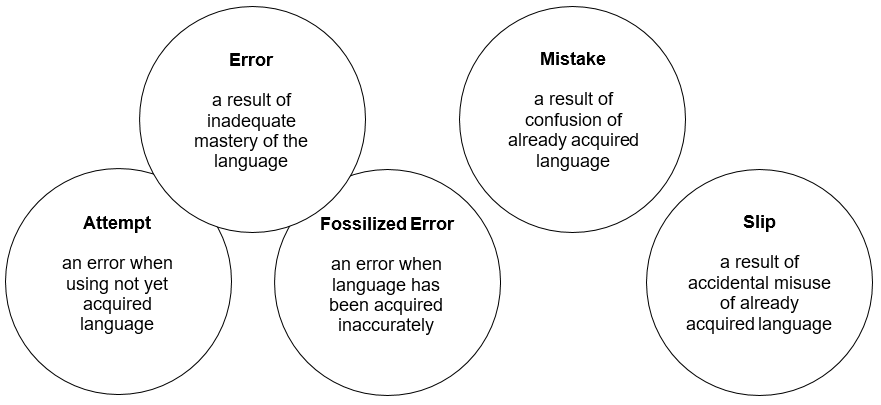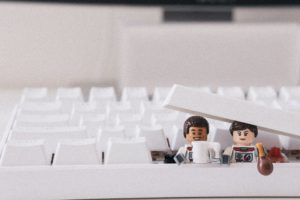In English language teaching, error correction is something which is expected of teachers, so what error correction techniques are there to make the most out of the errors we correct? And how can we make sure that correction is helping our students?

As teachers, we are told that error correction is necessary. However, the value of error correction has long been discussed. Is what we are doing enough or should we stop altogether? In our post-method, eclectic, throw-everything-at-them-and-something-is-bound-to-stick era we need to be aware of the options available so we can decide what is best for us and our students.
Contents
Maybe you’re right, maybe you’re wrong
This title was based on the Cat Stevens classic “Maybe you’re right”. Listen to the song on YouTube.
Expert opinions on error correction have evolved over the years. Take a look at these quotes and consider which one most closely represents your personal opinion.
- Like sin, error is to be avoided and its influence overcome, but its presence is to be expected – Brooks (1960)
- Error correction is a serious mistake because it puts students on the defensive and causes them to avoid complex constructions – Krashen (1982)
- You should tell students they are making mistakes, insist on accuracy and ask for repetition – Harmer (1983)
- There is a place for correction, but we should not overestimate it – Ur (1996)
- Feedback on learners’ performance in an instructional environment presents an opportunity for learning to take place – Larsen-Freeman (2003)
- Correction works best when done in context at the time the learner makes the error – Mackay (2007)
From error being seen as sin during the height of audiolingualism to viewing error as opportunity to learn, errors and correction have been a hotly debated topic in the ELT world.
This is why there is such a challenge for teachers. We must withdraw ourselves from our opinions and expectations in order to evaluate students on an individual level when it comes to errors. We then have to balance this with an institutional and cultural expectation to be corrected in the classroom.
Importantly, we have to ensure the learner has understood the correction, internalised it and improved their personal language system or interlanguage.
Interlanguage is a concept that refers to each learner’s personal knowledge of a 2nd language. It is the language which they know as they have learned it with potential for influence from their 1st language and overgeneralization of certain rules learned about their 2nd language. Hence the potential for error.
A learner’s interlanguage is unique to them. It is all they are able to use to communicate and it is what, as teachers, we are aiming to improve in each class, even in each interaction we have with students.
What is an error?
In ELT there have traditionally been two categories, errors and slips.

Errors happen when a learner doesn’t have sufficient knowledge of the language. This could occur when they have never been exposed the language and make an error because they have no prior knowledge to refer to. These are known as attempts. Or errors could come from the language having been acquired incorrectly and as far as they are concerned they are correct. These are fossilized errors.
Slips are the opposite end of the error spectrum. Slips happen when a learner knows the language but due to the speed of conversation or other factors, they say or write something incorrect. These are often self-corrected or ignored. They even happen to native speakers when we mispronounce a word or mix up words in an idiom that we’ve used a million times. One interesting thing to note is that even at the highest bands of C2 level, Cambridge writing scales say that inaccuracies that occur as slips are perfectly acceptable. They are not something to be punished.
Personally, I think there a bit of a gap here. We need something to fill in the middle ground. That is what I refer to as mistakes. Mistakes happen when a learner forgets the language that they have already acquired. It’s not that they don’t have the language, it’s that they haven’t accessed it correctly. Typical mistakes would come from L1 influence and often involve the use of false cognates or word order. The over-application of L1 rules in L2 frequently causes mistakes. This could happen to native speakers too, especially children. The typical example is when they conjugate an irregular past verb incorrectly (e.g. teached) because they have learnt a new rule and they start applying it too much.

When should we correct?
Correcting errors
Errors are the most difficult to correct, because not only are you providing a correction, you are also providing the knowledge necessary to fill the student’s gap in understanding. Errors should always be corrected, however, you need to be very careful about when and how to correct them.
We’ve all been in the situation where we try to correct an error quickly, only to get pulled down a rabbit hole where before we know it the board is covered in example sentences, phonemes and an explanation of the present perfect continuous. So correction of errors has to be structured and formulated in a way that allows students to recognise how to form the correct language, but without breaking the flow of the class.
Correcting mistakes
Mistakes should be dealt with completely differently. Mistakes are not due to lack of knowledge. Therefore, if you delay correction, the student will look at the error and instantly know what the problem is. They will think something along the lines of “Oh yeah, I knew that”. So what have we achieved as a teacher at that point? We haven’t helped to fill any gaps in knowledge.
That’s why mistakes should be corrected the moment they are made, even during a fluency activity. If you correctly identified the problem as a mistake, not an error, the correction should be quick and easy.
Correcting slips
Slips don’t need to be corrected at all. Slips are like your mother always confusing you and your sibling’s names. You know that she knows who you are, she just can’t ever seem to get it right. Correcting your mother may be satisfying for you as the corrector, but it’s not going to help her understand better who you are. And it might just make her flustered.
Correction in exam preparation classes
This is a blog about exam preparation after all. In many ways, everything that applies to error correction in general also applies to exam preparation classes. However, if anything, correction is even more important and even more expected. In general, we want our students to achieve successful communication and be intelligible. Unfortunately, for exams, this is often not enough.
The burden of correction falls even harder on the exam teacher. Insist on accuracy and demand the most of your students. They will thank you for it in the end.

Error correction techniques
There are many different types of error correction. Some of these we are taught how to do, while some of them come naturally. Some of them we would use in normal everyday situations.
Have you ever been in a shop and someone walks up to you to ask you where something is because they think you work there? How would you correct that person? You would probably say “I don’t work here” and for some reason apologise for their mistake. What you wouldn’t do is launch into a long explanation of why you choose to be an English teacher, not a shop assistant. And you wouldn’t start miming confusion and pointing across the shop to the employees who do work there.
That’s because certain correction techniques work better in some situations than others. Some work better for one type of error than for another. As teachers in the post-method era, we need to have an extensive bank of error correction techniques that we can dip into whenever we feel it’s necessary.
That’s our responsibility as teachers, to have the knowledge to be able to employ different techniques in different contexts.
Classic error correction techniques
| Metalinguistic explanation S – She has a long black hair. T – Hair is an uncountable noun so it doesn’t take the indefinite article. |
| Repetition S – In the morning, I get up at seven o’clock, clean my tooth, have breakfast and go to work. T – You clean your tooth? |
| Direct explicit correction S – It is dangerous to smoke while you become pregnant. T – While you become pregnant is very different. You mean while you are pregnant. |
| Peer correction During an in class written activity where students complete a letter in pairs: S1 – Feel free to contact me if you are a problem. S2 – I think it’s have a problem. |
| Delayed correction S – The cheerleaders threw up high into the air. T writes the sentence down in a notebook and puts it up on the board after the activity. The whole group corrects the sentence. |
| Recast S – When we won, I was so exciting. T – You were excited. |
| Paralinguistic explanation S – Last night, while I was eating dinner, I started /dʒəʊkɪŋ/ so my friend hit me. T – Makes a facial expression of confusion. Mimes laughing and choking. |
| Elicitation S – Waiter, could you bring me some tissues, please? T – Could you bring me some ……, please? |
| Clarification request S – You can’t sleep in my room because it is too crowded, but you can sleep with my sister. T – Excuse me? |
| Tell them they are wrong Teacher hands out a worksheet S – I hope this the last /ʃɪt/ for today. T – That’s not how you pronounce that word. |
Any and all of these correction techniques are acceptable and recommendable in the classroom. However, it is your role as a teacher to choose the best form of correction for the moment you correct.
Studies have shown, for example, that recasts, despite being the most common form of correction, are often overlooked. Students don’t notice they are being corrected. This happened more often with groups of Italian students than it did with groups of Japanese students. That’s because Japanese students have a significantly different mentality towards learning languages and were more attuned to the recast being an opportunity to learn.
Similarly, some students may like having their errors highlighted and displayed on the board after an activity while for others this could cause substantial embarrassment, thus lowering their motivation and causing them to avoid complex language in future interactions in order to avoid error in the future.
This is why we have to have a bag of tricks when it comes to error correction. There is no one-size-fits-all solution.
Adapted error correction techniques
While all of the above techniques are useful and acceptable depending on the context and circumstances, there is definitely a way to make error correction more interesting and ensure you are improving your students’ interlanguage.
Here are a couple of ideas that I have found to be effective:
Post-it correction

Method:
- Write errors on post-its or small pieces of paper.
- Slip those papers to the pair or group when they are done with the activity.
- They work together to write corrections on the same paper.
Benefits:
- Students are correcting their own errors rather than the smartest student in the group correcting everyone’s errors.
- Great for fast finishers.
- Post-its are fun.
Error collection

Method:
- Keep a record of errors on Google Slides or Quizlet.
- Add to this record whenever there is a recurrent error.
- Use as a warmer or cooler to recycle correction.
- Can be adapted into games like back-to-the-board.
Benefits:
- Helps with fossilised errors.
- Avoids the judgemental effect of constantly correcting the same mistake.
- Can be shared with students.
Stem correction

Method:
- Write only the stem of the incorrect sentence on the board.
- Students think of different ways to finish the sentence correctly.
- The mistake is never explicitly stated, but the student who made it will probably realise that it was something they said.
Benefits:
- Helps students upgrade language.
- Forces students to notice the language.
- Takes the pressure off the teacher and the student.
Anticipation

Method:
- Think about the errors students always make, especially before a certain grammar point that you have taught before.
- Before the activity write them up on the board with a big cross through them. Tell the students to be careful about these mistakes.
Benefits:
- Reminds students to think before they misspeak.
- Can be used as a visual aid if anyone does make the mistake.
- Makes you look like a clairvoyant.
Conclusions
Whether you are teaching 1-to-1, exam preparation or conversation classes, ensure that error correction is present in all your lessons. The expectation for correction is clear and its benefit is established.
One of the best things you can do as a teacher is aid language acquisition through targeted and effective corrective feedback that embraces the concepts of noticing and demanding high while ensuring the advancement of learners’ individual language systems.


What a genuinely well thought out and clearly written article. Great research too.
The section on types of correction is particularly practical. The only thing I would add is that encouraging students to self correct is vital. You did allude to that somewhat in the Stem Correction section. Myself, in that method, I use individual letters at the start and/or end of the word to jog memory. I think they feel even better when they remember the word with only one or two letters.
Again, damn good stuff! (That particular Cat Stevens song though? Not one of his best…)
Hi Brett!
I agree that self correction is definitely something that teachers and students should work towards although it would only work with mistakes where the students is aware of the language involved. The form of elicitation that you suggest is great and students do appreciate being able to self correct.
Thanks for the comment!